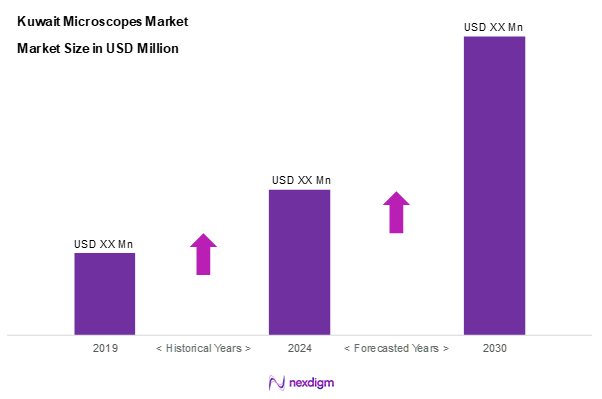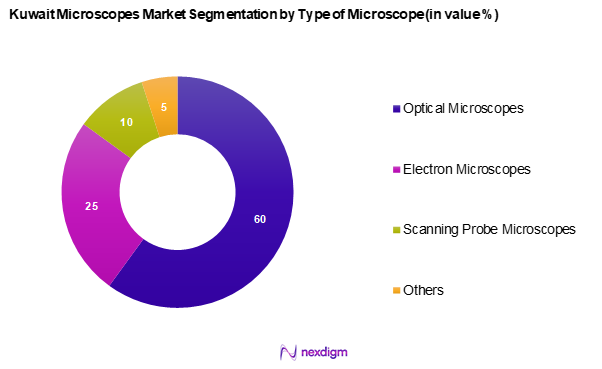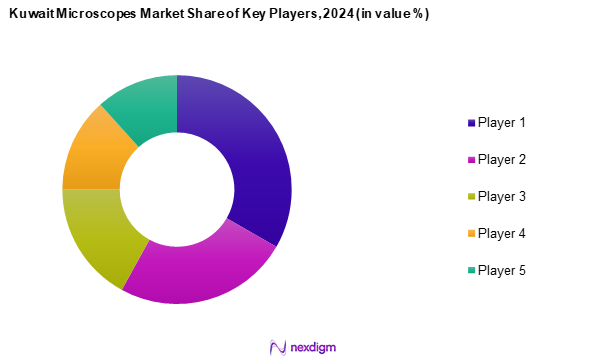Market Overview
As of 2024, the Kuwait microscopes market is valued at USD ~ million, with a growing CAGR of 8.4% from 2024 to 2030. This market expansion is driven by several factors, including the increasing emphasis on research and development across various sectors, as well as rising healthcare needs that require advanced microscopic techniques for diagnostics and analysis. The demand for high-quality imaging and enhanced accuracy in scientific research is propelling the usage of sophisticated microscopes in laboratories, educational institutions, and medical setups.
Major cities such as Kuwait City and Hawalli dominate the Kuwait microscopes market due to their concentration of academic institutions, research labs, and healthcare facilities. The presence of prominent universities and research organizations in these urban hubs significantly boosts the market demand for microscopes. Furthermore, these cities are well-equipped with the required infrastructure to support advanced scientific endeavours, making them crucial focal points for the microscope industry.

Market Segmentation
By Type of Microscope
The Kuwait microscopes market is segmented into optical microscopes, electron microscopes, scanning probe microscopes, and others. Optical microscopes lead this segment due to their versatility and widespread application in educational institutions and laboratories. As they offer sufficient magnification for numerous applications ranging from basic biology to complex medical diagnostics, their affordability and ease of use make them the most sought-after choice among end-users. The familiarity of researchers and students with optical microscopes has further solidified their position in the market.

By Application
The Kuwait microscopes market is segmented into life sciences, material science, nanotechnology, environmental analysis, and education. The life sciences segment dominate the largest market share due to rising demand for histopathology and related diagnostic procedures in healthcare settings. This application often relies on high-resolution images provided by microscopes for analysing biological samples. As the healthcare industry advances, the need for accurate and timely diagnostics is further augmented, leading to increased investment in microscopic technologies within this sector.

Competitive Landscape
The Kuwait microscopes market is characterized by a few major players that dominate the sector, including local and international brands such as Nikon, Olympus, and Leica Microsystems. This concentration highlights the significant influence these leading firms have on market trends through innovation, quality assurance, and extensive distribution networks. Their established reputation often assures customers of reliability and cutting-edge technology, thus shaping the competitive landscape significantly.
| Company | Establishment Year | Headquarters | Revenue (Estimated) | Major Product Lines | Number of Employees | Market Focus |
| Nikon Corporation | 1917 | Tokyo, Japan | – | – | – | – |
| Olympus Corporation | 1919 | Tokyo, Japan | – | – | – | – |
| Leica Microsystems | 1869 | Wetzlar, Germany | – | – | – | – |
| Thermo Fisher Scientific | 1956 | Waltham, MA, USA | – | – | – | – |
| Bruker Corporation | 1960 | Billerica, MA, USA | – | – | – | – |

Kuwait Microscopes Market Analysis
Growth Drivers
Increasing R&D Activities
The growing investment in research and development (R&D) across various sectors is a major driver for the Kuwait Microscopes Market. The government has been significantly increasing funding to strengthen scientific capabilities and innovation in healthcare and education. Efforts to establish Kuwait as a regional knowledge hub have led to the expansion of institutions dedicated to scientific research, where advanced microscopy techniques are increasingly utilized. These advancements support breakthroughs in medical diagnostics and material science, indicating a sustained demand for high-quality microscopes as R&D activities continue to grow.
Rising Demand in Pathology
The increasing demand for microscopy in pathology is driven by the rising prevalence of diseases and the need for accurate diagnostic tools. The healthcare sector is undergoing significant reform, with a strong emphasis on improving diagnostic services. The growing reliance on microscopes for disease diagnosis has led to increased investments in advanced diagnostic technologies. As healthcare infrastructure expands and services become more sophisticated, the demand for high-quality microscopy equipment is expected to rise, further boosting market growth.
Market Challenges
High Initial Investment Costs
One of the key challenges in the Kuwait Microscopes Market is the high cost associated with advanced microscopy equipment. High-end microscopes require substantial investment, which can be a barrier for small laboratories and educational institutions. Additionally, ongoing maintenance and operational expenses add to the financial burden. Many institutions depend on grants or government support to acquire such technology. Limited funding options for smaller laboratories may restrict their ability to adopt advanced microscopy solutions, potentially slowing market expansion.
Limited User Knowledge
A shortage of skilled professionals proficient in modern microscopy techniques presents another challenge for the market. The lack of specialized training programs in STEM fields has led to a gap in expertise, impacting both healthcare and research sectors. This shortage limits the effective utilization of microscopes, resulting in lower operational efficiency. Addressing this skill gap through enhanced education and training initiatives will be crucial for the broader adoption of advanced microscopy technology.
Opportunities
Growth of Biotechnology Sector
The expansion of the biotechnology sector presents significant opportunities for the Kuwait Microscopes Market. The government has prioritized biotechnology as part of its long-term economic diversification strategy, fostering innovation in health and agriculture. Increased funding for biotechnology research is driving the demand for advanced microscopy technologies. As new research facilities emerge, the application of microscopy in biopharmaceuticals, genetic research, and agricultural science is expected to grow, offering promising avenues for market development.
Rising Demand for Compound Microscopes
The increasing demand for compound microscopes is driven by their versatility and essential role in education and laboratory settings. Educational institutions are actively upgrading their laboratories to incorporate advanced microscopy into science curricula. The commitment to enhancing educational resources has led to significant investments in modern microscopy equipment. As schools and universities continue to integrate advanced scientific tools into their programs, the demand for compound microscopes is expected to remain strong, supporting long-term market growth.
Future Outlook
Over the next five years, the Kuwait microscopes market is expected to experience notable growth driven by increasing investments in healthcare and educational infrastructure, coupled with advancements in microscope technology. As the demand for precision instruments escalates, driven by ongoing research in various scientific fields and growing public awareness about health diagnostics, the market is set to expand. Continuous government support for technology enhancement and education will also play a critical role in bridging the gaps and fulfilling the increasing requirements of modern laboratories.
Major Players in the Market
- Nikon Corporation
- Olympus Corporation
- Leica Microsystems
- Thermo Fisher Scientific
- Bruker Corporation
- Hitachi High-Technologies Corporation
- Keyence Corporation
- Motic
- Labomed
- Eppendorf AG
- Accu-Scope Inc.
- Parco Scientific
- Celestron
- Zeiss AG
- Gautier Scientific
Key Target Audience
- Investments and Venture Capitalist Firms
- Government and Regulatory Bodies (Kuwait Institute for Scientific Research, Ministry of Health)
- Medical Research Institutions
- Pharmaceutical Companies
- Biotechnology Firms
- Hospitals and Healthcare Providers
- Industrial Laboratories
- Quality Control and Assurance Departments
Research Methodology
Step 1: Identification of Key Variables
The initial phase involves constructing a comprehensive ecosystem map that covers all principal stakeholders within the Kuwait microscopes market. This step is supported by extensive desk research that utilizes a combination of secondary and proprietary databases to gather detailed industry-level information. The primary objective is to identify and define critical variables influencing market dynamics, such as trends, drivers, and challenges.
Step 2: Market Analysis and Construction
In this phase, historical data pertinent to the Kuwait microscopes market will be compiled and analyzed. This includes assessing market penetration, the ratio of product types to operational entities, and the resultant revenue generation. Additionally, an evaluation of service quality statistics will be conducted to ascertain the reliability and accuracy of the revenue estimates derived from the data collected.
Step 3: Hypothesis Validation and Expert Consultation
Market hypotheses will be developed and subsequently validated through consultations with industry experts, utilizing computer-assisted telephone interviews (CATIs). These consultations will encompass a diverse array of companies within the microscopy field, providing valuable operational and financial insights that are instrumental in refining and corroborating the market data.
Step 4: Research Synthesis and Final Output
The final phase will involve engaging directly with multiple microscope manufacturers to acquire detailed insights into product segments, sales performance, consumer preferences, and other crucial factors. This interaction will serve to verify and complement the statistics derived from the previous analytical steps, ensuring a comprehensive, accurate, and validated analysis of the Kuwait Microscopes Market.
- Executive Summary
- Research Methodology
(Market Definitions and Assumptions, Abbreviations, Market Sizing Approach, Consolidated Research Approach, Understanding Market Potential Through In-Depth Industry Interviews, Primary Research Approach, Limitations and Future Conclusions)
- Definition and Scope
- Overview Genesis
- Timeline of Major Players
- Business Cycle
- Supply Chain and Value Chain Analysis
- Growth Drivers
Increasing R&D Activities
Rising Demand in Pathology - Market Challenges
High Initial Investment Costs
Limited User Knowledge - Opportunities
Growth of Biotechnology Sector
Rising Demand for Compound Microscopes - Trends
Integration of AI in Microscopes
Increased Adoption in Quality Control - Regulatory Landscape
Compliance with International Standards
Patent Regulations - SWOT Analysis
- Stakeholder Ecosystem
- Porter’s Five Forces
- By Value, 2019-2024
- By Volume, 2019-2024
- By Average Price, 2019-2024
- By Type of Microscope, (In Value %)
Optical Microscopes
Electron Microscopes
Scanning Probe Microscopes
Others - By Application, (In Value %)
Life Sciences
Material Science
Nanotechnology
Environmental Analysis
Education - By Distribution Channel, (In Value %)
Online Sales
Offline Retail
Direct Sales - By Region, (In Value %)
Kuwait City
Hawalli
Ahmadi
Salmiya
Other Regions - By End-User Sector, (In Value %)
Academic Institutions
Healthcare Organizations
Industrial Laboratories
Research Institutes
- Market Share of Major Players on the Basis of Value/Volume, 2024
Market Share of Major Players by Type of Microscope Segment, 2024 - Cross Comparison Parameters (Company Overview, Business Strategies, Recent Developments, Strengths, Weaknesses, Organizational Structure, Revenue, Distribution Channels, Number of Dealers, Margins, Unique Value Offering, and more)
- SWOT Analysis of Major Players
- Pricing Analysis Basis SKUs for Major Players
- Detailed Profiles of Major Companies
Nikon Corporation
Olympus Corporation
Zeiss AG
Leica Microsystems
Hitachi High-Technologies Corporation
Thermo Fisher Scientific
Keyence Corporation
Bruker Corporation
Becton Dickinson
Motic
Eppendorf AG
Labomed
Accu-Scope Inc.
Parco Scientific
Celestron
Others
- Market Demand and Utilization
- Purchasing Behavior
- Regulatory and Compliance Needs
- Needs, Desires, and Pain Points
- Decision-Making Process
- By Value, 2025-2030
- By Volume, 2025-2030
- By Average Price, 2025-2030


